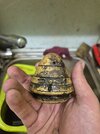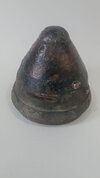Agreed it's a lovely example. If it came from water, keep it in water, this will hopefully keep the filling wet and less susceptible to initiation. If you notify the police they will task an EOD team to your fuze and the likelihood is you will never see it again. It's a shame but if you want to keep your hands and your life then that is what you may have to do. If it comes to an EOD team being tasked, all you can do is ask the EOD Operator to use as little explosive as possible, and ask for the blown fuze to be handed back to you afterwards. You will not get it back unless the Operator is certain it contains no more explosive. This may, however, not be part of what they are allowed to do. I think in my day we could be a little more discretionary about things like this., but that was over 30 years ago, and times move on.
 Found this nice no.80 fuse last night- but only realised its unfired when I got home. Its in great nick and something I hope can be saved. Im aware these can be dangerous, is there anywhere I can get it safely disarmed and then kept?
Found this nice no.80 fuse last night- but only realised its unfired when I got home. Its in great nick and something I hope can be saved. Im aware these can be dangerous, is there anywhere I can get it safely disarmed and then kept?
